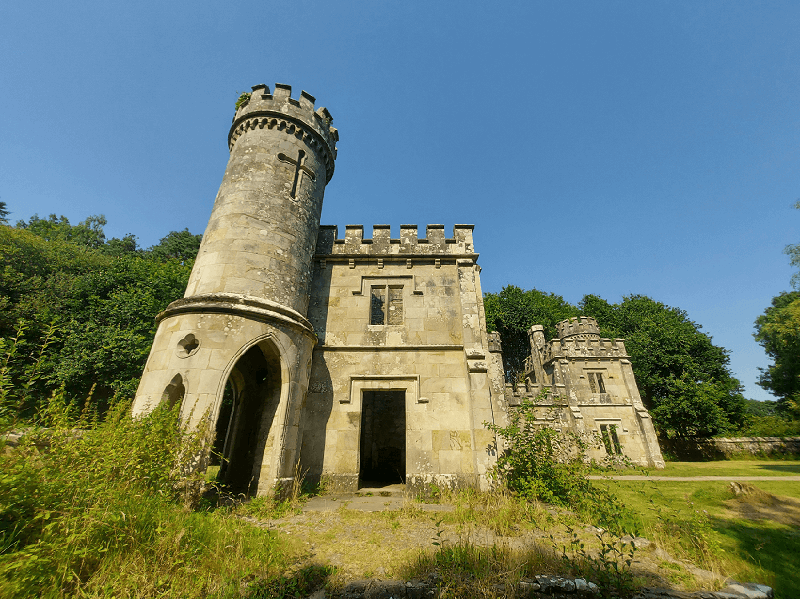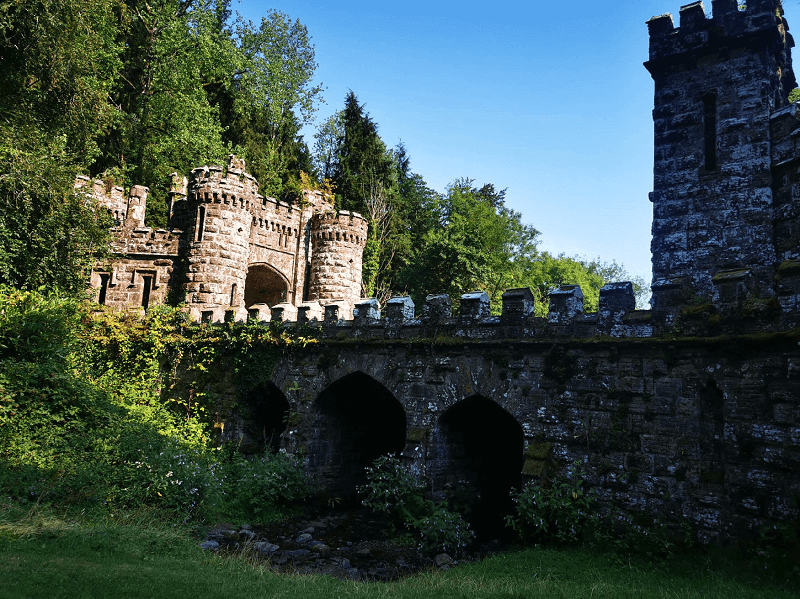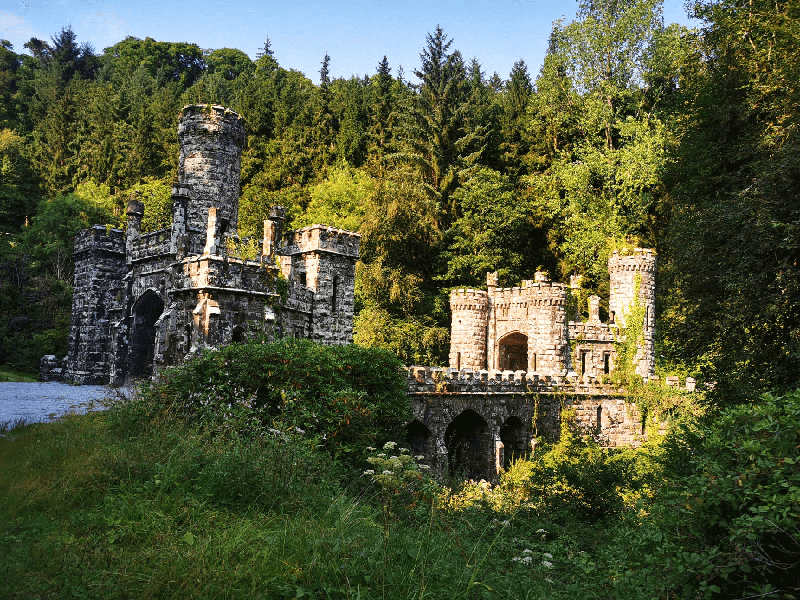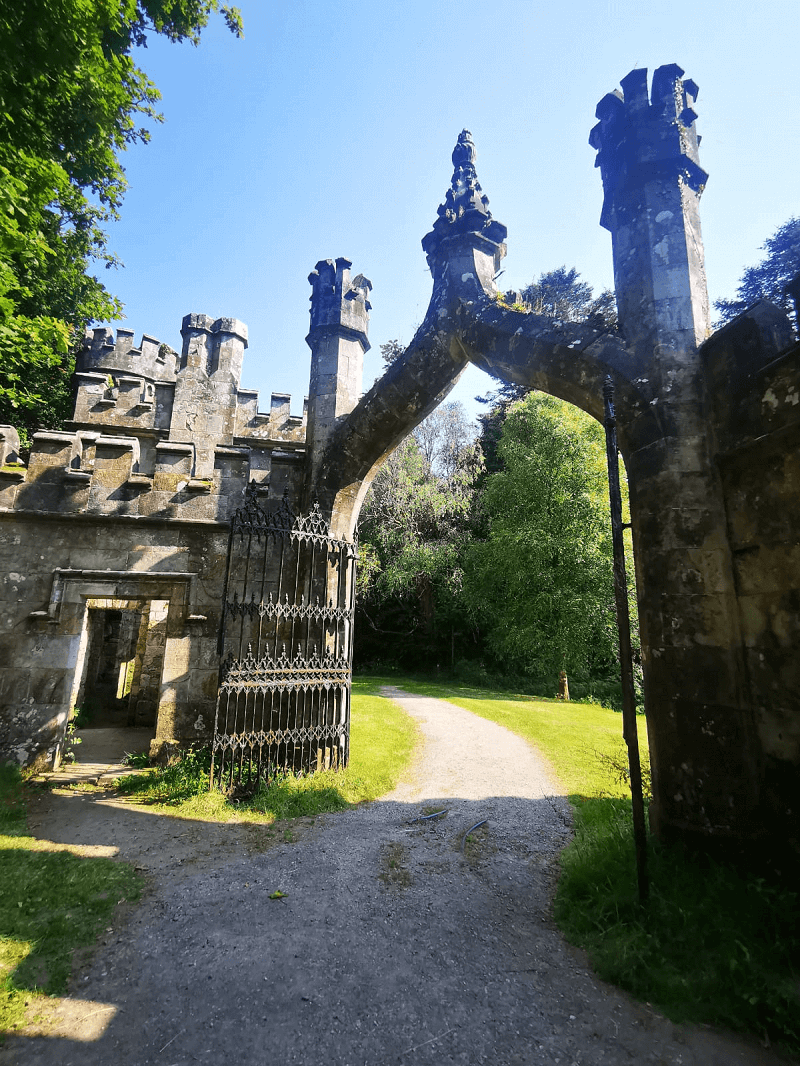History
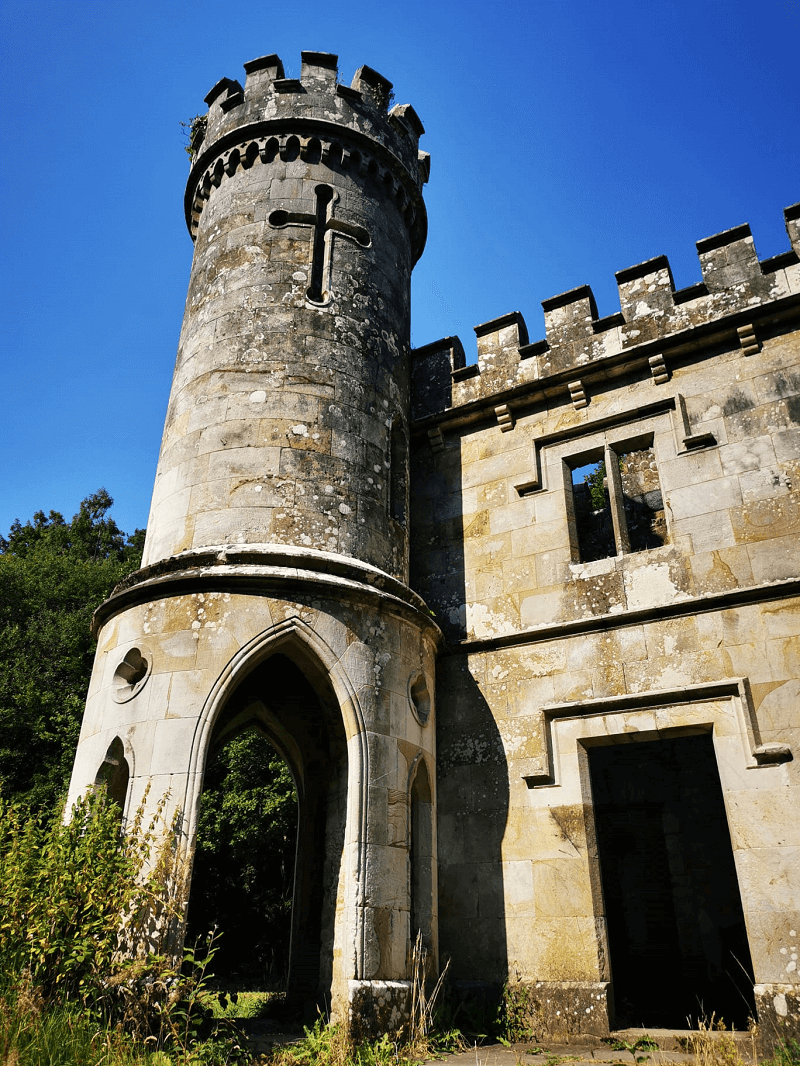
The full site consists of a gate-house (also known as the Gatelodge) and the Ballysaggartmore Towers [1],
connected by two roads running on the two sides of the Blackwater river.
A very interesting report describing the Ballysaggartmore site, dating 1834, can be found in [2]
and includes detailed illustrations sketching the gate-house and the castle.
According to [3], it was between late 18th/early 19th century that George Holmes Jackson of Glenmore
sold the land around Ballysaggartmore to John Kiely (also sometimes spelled Keily).
 After his death in 1808, the property when to his sons, John Kiely and Arthur Kiely [1, 3].
John was the elder brother and inherited Strancally, where he commissioned the construction of another castle,
while Ballysaggartmore went to Arthur, who inherited more than eight thousand acres
of land in County Waterford [1, 3-6],
the majority of which was rented and approximately one thousand acres were intended for personal demesne [5].
Here the history of the Ballysaggartmore site begins:
After his death in 1808, the property when to his sons, John Kiely and Arthur Kiely [1, 3].
John was the elder brother and inherited Strancally, where he commissioned the construction of another castle,
while Ballysaggartmore went to Arthur, who inherited more than eight thousand acres
of land in County Waterford [1, 3-6],
the majority of which was rented and approximately one thousand acres were intended for personal demesne [5].
Here the history of the Ballysaggartmore site begins:
 once back from the Napoleonic Wars in which he had fought, in the second decade of 19th century,
Arthur Kiely built an initially modest, comfortable and unassuming residence in Ballysaggartmore [3, 4-6].
once back from the Napoleonic Wars in which he had fought, in the second decade of 19th century,
Arthur Kiely built an initially modest, comfortable and unassuming residence in Ballysaggartmore [3, 4-6].
Perhaps, feeling in competition with the bigger Strancally castle owned by his brother,
Arthur invested considerable resource in expanding the Ballysaggartmore building,
leading him to financial difficulties during the 1830s [3].
Meanwhile, in 1843, driven by his social ambition and perhaps instigated
by his wife Elizabeth Martin of Ross House, Arthur Kiely changed his surname to Kiely-Ussher,
a family name derived from the ancestors on his mother’s side,
as the Usshers were a long established family in the area [3, 4].
The already critical financial situation was aggravated by the great famine (1845-1848),
during which tenants were not able to pay rents [1, 3].
The situation in Ireland was dramatic: the population in Waterford was dying by starvation [4].
 As Arthur Kiely had already planned to improve the estate by tearing down dilapidated old cottages
held by his tenants, he used the excuse of their defaults for eviction and demolition [3-6],
in order to free up land to raise livestock [4].
Oppositely, his brother John, owning the Strancally castle, was described as a compassionate landlord,
displaying liberality to the local poor [1, 3-4].
As Arthur Kiely had already planned to improve the estate by tearing down dilapidated old cottages
held by his tenants, he used the excuse of their defaults for eviction and demolition [3-6],
in order to free up land to raise livestock [4].
Oppositely, his brother John, owning the Strancally castle, was described as a compassionate landlord,
displaying liberality to the local poor [1, 3-4].
Maybe it was because of the lack of empathy towards his tenants that an attempt was made on Arthur’s life,
while crossing the lodge gates, for which seven men were found guilty and
deported to Tasmania in 1849 [1, 3-4, 6].
After the famine, with no tenants left paying the rent and therefore with no income,
Arthur Kiely had to put the property on the market [3].
It was finally in 1861, when William Morton Woodroofe bought the main house and the lands,
about a year before Arthur passed away [3].
At the beginning of 20th century, Hon Claud Anson,
a younger son of the second Earl of Lichfield, married the Irish Lady Clodagh de la Poer Beresford,
 daughter of the fifth Marquess of Waterford and, with the intention to move to her homeland,
he bought the Saggartmore property [3, 4-6].
Unfortunately, in 1922 Ballysaggartmore House was destroyed by fire and since then,
the house was left abandoned and its conditions worsened till it was pulled down some decades later [3, 4-6].
daughter of the fifth Marquess of Waterford and, with the intention to move to her homeland,
he bought the Saggartmore property [3, 4-6].
Unfortunately, in 1922 Ballysaggartmore House was destroyed by fire and since then,
the house was left abandoned and its conditions worsened till it was pulled down some decades later [3, 4-6].
The front lodges, however, survived and remained occupied until the 1970s,
after which they too were abandoned and allowed to fall into ruin [3, 4-6].
Nowadays, we can still admire the gate-house and towers as an evidence of Arthur Keily extravagant plan,
often considered architectural “follies”, a physical memory of what once was greed and foolish ambition,
during some of Ireland's most devastating events, the terrible Famine [4].
References
- [1] Visions of the past, Ballysaggartmore Towers, Waterford, Ireland
- [2] E. H. “Ballysaggartmore Castle, Near Lismore.” The Dublin Penny Journal, vol. 3, no. 128, 1834, pp. 185–86. JSTOR
- [3] The Irish Aesthete, BALLYSAGGARTMORE
- [4] The Irish Place, The History of Ballysaggartmore Towers
- [5] Robert O’Byrne, "The Irish Aesthete: Ruins of Ireland", Cico Books, 2019
- [6] Wikipedia, Ballysaggartmore Towers
